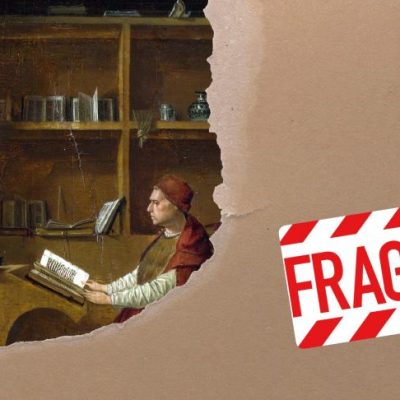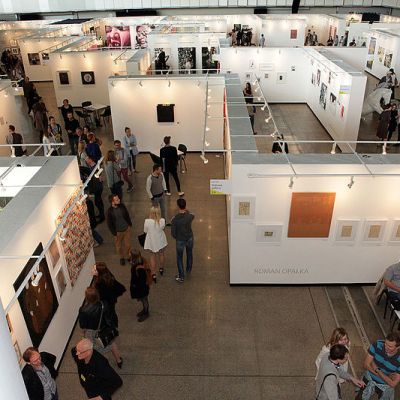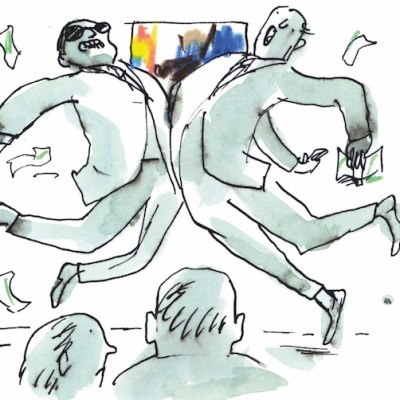Consider Dubai. Is that a flicker of a sneer? Few cities provoke such reaction, and few embody so many contradictions. A desert metropolis of five-star hotels and luxury malls, but still with the mood of a frontier; a land of opportunity, but with a tightly censored media. Such contradictions play out across the art scene in the United Arab Emirates; and although this has mushroomed in the past decade, two major institutional projects in the region, the Louvre and Guggenheim museums in Abu Dhabi are yet to materialise.
Both have been in the news again this year. In March, Thomas Krens, the former director of the Guggenheim Foundation in New York and the man who brokered the deal to set up the museum in Abu Dhabi in 2006, told Art Agency, Partners that it had been conceived at a far more ‘naïve’ time, before the financial crash and the Arab Spring. The Louvre, meanwhile, has said it will ‘welcome visitors in 2017’, although no precise date is set.
While Abu Dhabi and Sharjah are the UAE’s art hubs for non-profit organisations, Dubai is its market centre. Alserkal Avenue, a lively cluster of former warehouses in the industrial Al Quoz district, was established in 2007 by Abdelmonem Bin Eisa Alserkal and is now home to most of the city’s commercial galleries. When Vilma Jurkute joined as director in 2011, there were just six galleries in Alserkal. Now there are more than 60 art, design and creative spaces.
‘Dubai’s arts ecosystem, which started with just a few commercial art galleries a decade ago, has grown to become a holistic art scene,’ says Jurkute, citing the development of non-profit spaces that were previously lacking in Dubai, such as the Jean-Paul Najar Foundation and Art Jameel Project Space, both in Alserkal. The latter is a precursor to the ambitious Jameel Arts Centre, announced by director Antonia Carter (previously of Art Dubai) in March and due to open in Winter 2018 on Dubai Creek.
In the past two years, Alserkal has attracted a couple of international galleries among the homegrown. Stéphane Custot opened Custot Gallery Dubai in March 2016, adding to his London gallery, Waddington Custot; New-York based Leila Heller also opened a 14,000 square-foot gallery in 2015. ‘I had been coming to the Middle East for the previous 13 years and have a very large client base in the region,’ says Heller. ‘I have relationships with curators in the MENA region as well as in Southeast Asia, and thought that we should have a physical presence there as well, since we were spending so much time traveling back and forth.’
Heller first visited Dubai in 2006, since when the market has grown ‘exponentially’, although it still needs ‘more people who are trained in the art world and have experience working in museums and galleries – but this is in the works.’ Collectors are, she finds, ‘curious and eager to learn and experiment,’ in contrast to the ‘blasé’ sorts she finds elsewhere.
Alserkal Avenue in Al Quoz, Dubai, the city’s industrial district

It’s hard to speak of a local market in a country in which 90 per cent of the population are expatriates. Heller’s clients here come from across the Gulf region, and from Southeast Asia, Lebanon, Turkey, and Central Asia. Of the works Custot has sold here, ‘maybe only 10 per cent were to Emiratis’, and his clientele largely consists of French, British, Indian, and Lebanese expats. Of the gallery’s first year, Custot says that ‘I have not made much but I have not lost anything, which is surprising for the first year of an art gallery.’
Lower overheads help – whereas Custot’s Mayfair gallery costs $500,000–$600,000 per year in rent, the far larger space in Dubai costs $150,000. ‘In a way, it’s a laboratory,’ says Custot. ‘The gallery I have in the UK is more established, so people expect more classic modern and contemporary art.’ In Dubai he exhibits emerging artists who he wouldn’t display in London and, in January 2018, he plans to mount an exhibition of artist-designed jewellery. But he is finding a market for higher-value works by more established names, too: ‘At Abu Dhabi Art, we sold a painting by Marc Quinn for over $150,000. We’ve sold maybe five or six works here for over $100,000.’
Lawrie Shabibi, established by William Lawrie and Asmaa Al Shabibi, moved into Alserkal Avenue in 2011, when only three galleries had set up there. The Dubai market is currently experiencing a shift in focus towards modern art, thinks Al Shabibi, ‘so while in the past collectors and buyers were gung-ho about younger artists, this has changed – there is a strong trend of revisiting artists or discovering artists who may have been missed. This may be because these works are seen as providing more security from an investment perspective.’ While such historical works add depth to collections, this development also contributes to the lack of a vibrant secondary market for contemporary art, which, Al Shabibi says, ‘is what is lacking in Dubai right now’.
Running a gallery in Dubai is, she says, challenging but satisfying, but the gallerists must travel to get noticed, so their costs are high. ‘Given that the Dubai market is quite small, participating in art fairs becomes essential in order to widen our client base. The lack of institutions in Dubai also means looking outwards to place our artists in museum shows or collections.’
This March, Lawrie Shabibi exhibited at Art Dubai, the highpoint of Dubai’s art calendar. The gallery was among the regional names, alongside a few international heavyweights such as Victoria Miro and Marlborough Gallery, at what is a strengthening fair. Myrna Ayad, who was appointed as Art Dubai’s director last year, thinks Dubai is still the best place to discover modern and contemporary art from the Middle East, North Africa and South Asia. ‘Our first edition in 2007 brought together 40 galleries and attracted 8,000 visitors,’ she says. ‘A decade later, Art Dubai welcomed 94 galleries from a record 43 countries, and 28,000 visitors.’ She is particularly proud of the fair’s first Modern Symposium this year; in the absence of institutions and a fully fledged art-education system, market players see their role as in part educational, albeit with commercial interests.
Bonhams, Sotheby’s and Christie’s all bring highlights of their Indian and Islamic, and Middle Eastern modern and contemporary art auctions from London to Dubai. Only Christie’s holds sales on the ground, although this year it will shift its October season back to London, leaving only the March sales in Dubai. Christie’s opened its Dubai office in 2005, since when, says managing director Michael Jeha, international interest in Middle Eastern art has accelerated in tandem with the domestic scene: ‘A lot of initiatives have been seen, and many have survived, and this flame of promoting culture and developing arts education needs to be maintained – and could benefit from fresh initiatives.’
This spring, Sotheby’s also staked a claim in the region by opening a gallery in Dubai, reflecting, says Edward Gibbs, chairman of Sotheby’s Middle East and India, the ‘significant growth in the number of Middle Eastern clients participating in our global sales’. Although Sotheby’s plans an events programme (mainly focused on jewellery and watches, for which there is a voracious local market), no Dubai sales are planned.
Dubai’s art scene is undoubtedly precocious. But is it sustainable, and will it consolidate itself at a time when the oil market is faltering? And will the UAE ever graduate from being an intriguing art-world hinterland to an unmissable destination for international curators and collectors? Its expat population is transient, and while it never struggles to attract workers, it often fails to retain them, so a stable collector base is difficult to build. But remember how young this market is – Christie’s had been holding sales in Hong Kong for 20 years by the time it set up in Dubai.
For now, the Middle East remains a small player on the global art market, surprising for an area so vast and so rich. ‘There is so much money but today the market is very limited,’ Custot says. ‘But for me the potential is there. I believe that when the Louvre Abu Dhabi opens, it will help build an community of collectors.’ He remains committed, and like many in this thrusting, uncompromising and, yes, brash city, is determined ‘to prove that I was right to go’.
From the July/August issue of Apollo. Preview and subscribe here.



